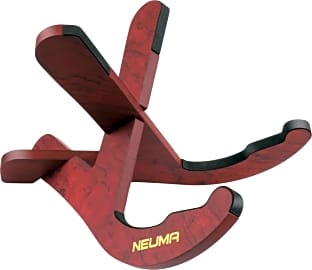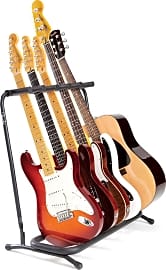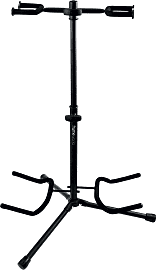The 10 Best Guitar Stands

This wiki has been updated 41 times since it was first published in September of 2015. Whether you need something for onstage use or a rack to display your impressive collection at home, one of these stands will take care of your precious instruments nicely. They are available in a variety of designs to accommodate different numbers of acoustic, electric, and bass guitars, as well as banjos and ukuleles. We've chosen both plain and more decorative models, so there's one for all. When users buy our independently chosen editorial selections, we may earn commissions to help fund the Wiki.
Editor's Notes
April 04, 2020:
It may be popular, but we've ultimately elected to remove the On Stage XCG4 Black, as it just doesn't offer the security that expensive instruments require. The Hola! Music and the Mugig LZJ-2 have become hard to find, so we've removed them, as well. Those who are looking for simple, inexpensive choices might instead consider the AmazonBasics A-Frame or the Gator Frameworks Double. These require no complicated setup or assembly, can be transported with relative ease, and are secure enough for most situations. If you want a more robust choice for better peace of mind — and don't mind paying for it — the D&A Guitar Gear Hydra or the Hercules Plus Series Duo might be better choices. They have plenty of features that will keep your guitar secure, including adjustment points and heads that offer gripping or locking capabilities. These can hold three and two instruments, respectively; if you need more room, consider the Hercules 5-Piece or the Fender Multi. Even though they can hold up to five instruments, they don't take up more floor room than is necessary, so they'll work even for smaller homes.
One final note about the nitrocellulose finishes sometimes found on both acoustic and electric guitars. Not all stands use foam and/or rubber that is compatible with these instruments, which can lead to damage over time. If your guitar has such a finish, be sure to check whether the manufacturer deems the stand to be appropriate. One safe option to consider is the Fender Deluxe, which has padded yokes that are safe for finishes that are on the more sensitive side.
Special Honors
Arpeggio7 by John Stass Signature The Arpeggio7 by John Stass Signature boasts solid cherry wood and a hand-rubbed oil finish, making it a handsome option that is sure to turn some heads. It protects well, too, thanks to a safety peg on the yoke and felt-lined contact points. artsyhome.com
The Carousel by A&S Crafted Products Six guitars can fit on The Carousel by A&S Crafted Products, but if that's not enough, an expansion tier is available for separate purchase that brings the total number of slots to 12. To guard against scratches, there's wool felt on all contact points, while neck gates keep each instrument firmly in place. guitarstorage.com
DRS Racks AB8 Although it measures only 23 inches in width, the DRS Racks AB8 is tall to accommodate two rows of guitars, giving you room for a total of eight instruments. The pieces feature sustainable, sturdy bamboo as well as padded supports that are deep enough to hold each neck securely. drsracks.com
What Do I Need to Consider Before Purchasing a Guitar Stand?
If, on the other hand, you play as a solo act or a part of an ensemble, you'll need to determine whether a particular stand is actually roadworthy.
The first thing anyone needs to consider before purchasing a guitar stand is where and how that guitar stand will be used. If you only own one guitar and you do not play that guitar anywhere but in your home, perhaps your only concerns would be whether a specific stand can support the weight and shape of that guitar, or whether a stand's color matches the surrounding decor.
If, on the other hand, you play as a solo act or a part of an ensemble, you'll need to determine whether a particular stand is actually roadworthy. Ideally, a traveling stand should be collapsible, or, at the very least, compact. In addition, you'll want a traveling stand to be relatively lightweight (i.e., approx. 3-12 lbs, depending on the number of guitars that stand will need to hold), and you'll also want to ensure that a stand fits proportionately along a stage, or in a rehearsal space.
In the event you own multiple guitars, you'll either want to buy a set of matching stands, or you'll want to invest in a multi-peg stand that can accommodate anywhere from 3-10 guitars, depending on your needs. The more elaborate a stand, the more you'll want to confirm that that model is durable, and that it can accommodate whatever style of guitar you use. Certain stands, for example, may be designed to cradle the framework of a standard electric or acoustic guitar, whereas a lap steel or a custom-made guitar may not sit well in the base.
Assuming you own an antique guitar, or one that is meant to be a showpiece (i.e., an autographed or limited-edition model), it may be worth investing in a handcrafted stand that reflects some prestige, especially if you plan on displaying that guitar inside your home, business, or office.
Why Is a Guitar Stand Such a Necessity?
Experienced musicians understand why a guitar stand is so important, whereas beginners might be justified in wondering what the necessity of a guitar stand might be. The simple answer is that a guitar stand is made for securing any guitar in a firm and upright position. But the more in-depth explanation has to do with keeping your instrument in tune, and pristine.
Experienced musicians understand why a guitar stand is so important, whereas beginners might be justified in wondering what the necessity of a guitar stand might be.
Most guitar stands are built with bottom rests for cradling a guitar's body, a pair of prongs for securing the guitar's neck, and a sturdy base. The alternative is leaning your guitar against a wall or a piece of furniture, where that guitar is all but bound to slide down or fall over. Having your guitar free fall onto the ground can - and probably will - result in broken strings, indelible scratches, pegs slipping out of tune, or worse.
If you play in any type of band or orchestra, you will be expected to have a stand for your guitar. Whether you're on a stage or in a pit, there isn't any room for leaving idle instruments about the floor, nor is it logistically possible to keep pulling instruments out of their cases whenever it comes time to use them. What's more, most guitarists prefer to tune their instruments prior to any show or recital. A stand will ensure that the guitar remains in one place - where it will not be moved or tampered with - until the performance begins.
Keeping a guitar in proper tuning is especially important if you've just begun learning how to play. Whereas placing a guitar inside a case could result in the tuning pegs getting readjusted, placing the guitar on a stand allows you to pick up in the same tuning as when you left off.
A Brief History of The Guitar
While there are stone carvings and ancient drawings of men playing a stringed instrument in the style and tradition of a guitar, the oldest definitive version of any such instrument dates back to the 12th century in Europe. This instrument was originally known as a chordophone, and it was designed with a pear-shaped body and a long, thin neck.
These instruments, which were usually designed with either four or five strings, spread throughout Eastern Europe over the next hundred years.
Eventually, the chordophone evolved into a four-stringed guitar, which was designed in the tradition of both an Arabian oud and a Mesopotamian lute. Early guitars were particularly popular among the Spanish and Latin cultures, both of which referred to the instrument as a guitarra. Over the next two centuries, different variations of the guitar began emerging throughout Europe. Regional models could be distinguished by virtue of their shape, width, fingerboards, and sound holes.
The Baroque and Renaissance guitars, which a lot of historians regard as the most recognizable ancestors of a modern guitar, were invented during the 16th century. These instruments, which were usually designed with either four or five strings, spread throughout Eastern Europe over the next hundred years. Whereas Renaissance guitars were very conservative and standard, Baroque guitars featured artistic flourishes and ornamental trim.
The acoustic guitar as we now know it emerged by way of French culture, thanks to a host of manufacturers, each of whom had begun to innovate as a way of outperforming one another. This innovation, combined with an increase in demand, eventually led to a more resonant six-stringed guitar. By the end of the 1800s, the acoustic six-string had become an industry standard.
The electric guitar emerged after American musicians started to experiment with amplifying a guitar's strings during the 1920s. By 1930, iconic manufacturers like Rickenbacker and Gibson were already working on their first electric prototypes. The electric guitar initially took off during the Big Band Era, based on a need for louder strings. After that, the electric became a hallmark of American jazz and blues. Today, the electric guitar is commonly associated with rock and roll, although it is also used across various musical genres the world over.















